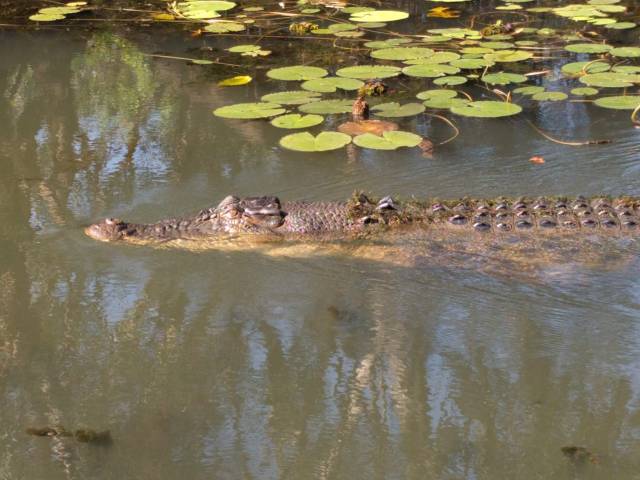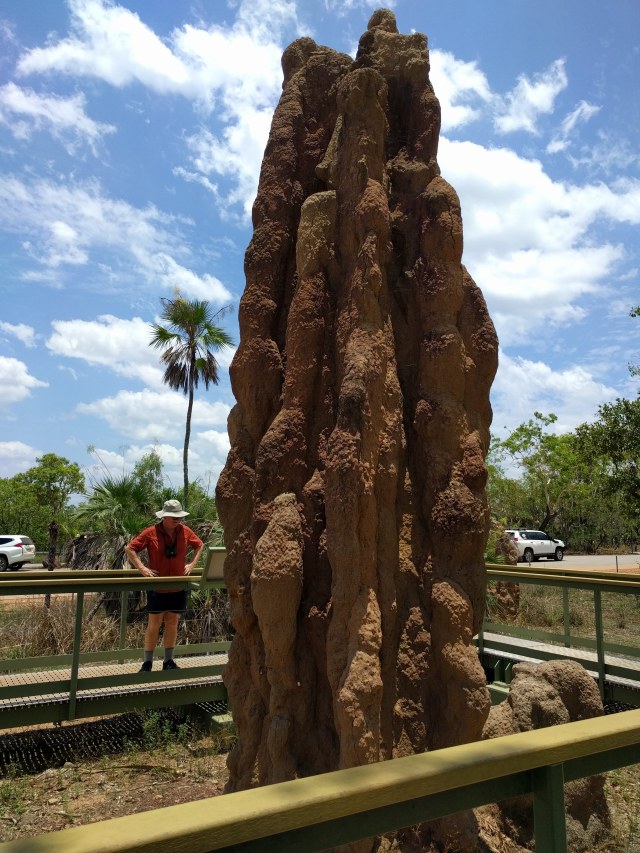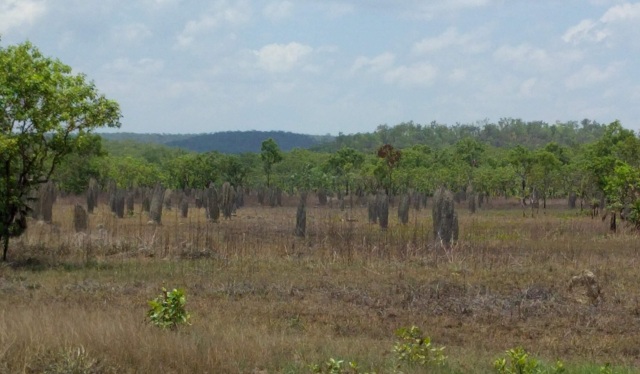
In Kakadu National Park we got within 10 feet of crocodiles!
The final few days of our Australian safari were focused on Kakadu National Park, a vast wetlands area to the southeast of Darwin that is nirvana for birders – and also for people who like to meet salt-water crocodiles like the one pictured above. In a 2 hour boat ride we must have seen nearly two dozen of these critters, ranging in size from 1 to 3 meters long. The females crocodiles are quite territorial, and we got to see several examples of one female chasing off another. But mostly they just glided gently through the water.
To our amazement, the wading birds seemed unfazed by the crocs. Then our guide, Rueben, explained that crocodiles can’t digest feathers, so they leave the birds alone.
We did, however, see a water buffalo cautiously approaching the river and swimming hurriedly across. Crocodiles are quite happy to eat water buffalo! (Here’s a video of the buffalo exiting the water )

Kakadu is nearly 20,000 square kilometers of wetlands — over twice the size of Yellowstone National Park in the USA. During the monsoon period, it becomes a huge lake with water up to 10 meters deep and is navigable mostly only by boat. While we were there (in “the build-up” season) the roads were still dry, and the river only 2 to 3 meters deep.

Sunset from the escarpment above the Kakadu wetland.
Like Uluru, Kakadu National Park is run by aboriginal people who have lived on the land for tens of thousands of years. The land around them has changed, but they have adapted. And while the tools they use have changed, they still live off the land as much as they can, eating crocodile, goose, etc.
Kakadu also has several places where indiginous people drew pictures and stories on the rock to teach the “dreamline” stories. And, like in Uluru, tourists learn only the briefest accounts of any of these sacred stories. It is humbling to realize what a complex culture these stories encode, and how late westerners were in coming to glimpse it. Our guide, Ruben, pointed out that aboriginals were not allowed to vote in the Northern Territories until 1965! (We also learned on this trip that for many years, the indigenous people were not even considered “people” but were counted as part of Australia’s “flora and fauna”!)

The other sight that impressed us as we traveled to and through the Kakadu area was the termite mounds.
We had been seeing hundreds of termite mounds by the side of the highway everywhere in the outback. But as we got further north, they got larger and larger. Here’s one that they have made into a tourist attraction in Litchfield Park, just south of Darwin — and it isn’t necessarily the biggest we saw!

These mounds (like the ones that were dressed up in a previous blog) are made by cathedral termites. They don’t eat wood. Instead, they eat whatever is on the ground and mix their feces with saliva to create spaces in the mound to grow a symbiotic fungus, which is their primary source of nourishment.
There’s another type of termite up here as well that builds equally strange homes — “magnetic termites” build hundreds of flattish slabs all lined up to point north/south. The reason? So that the sun only heats one side of the mound at a time, and eggs can be moved from side to side for temperature control

It looks a bit like a graveyard, but it is really just termite mound after termite mound!
Australia never seems to run out of weird, wacky wildlife!
